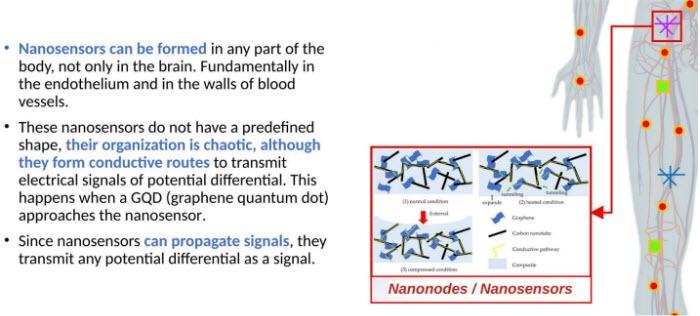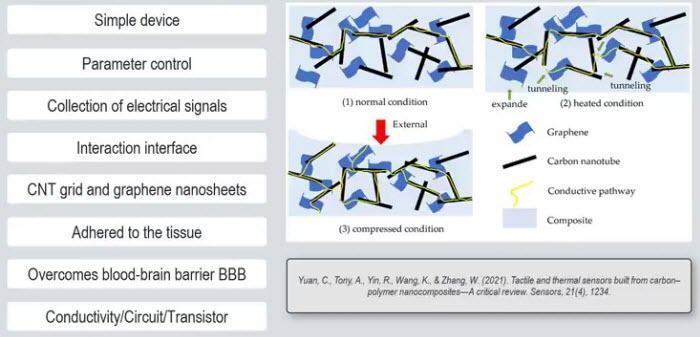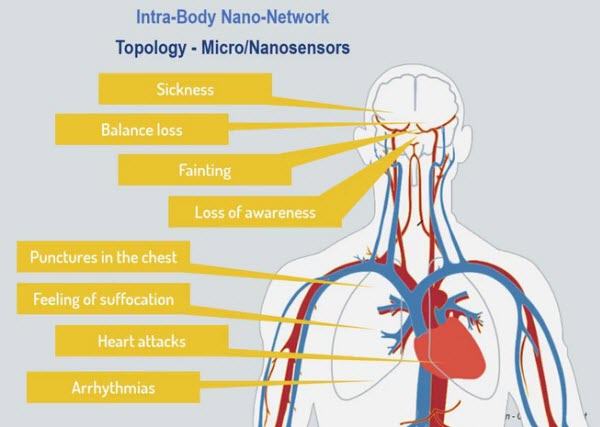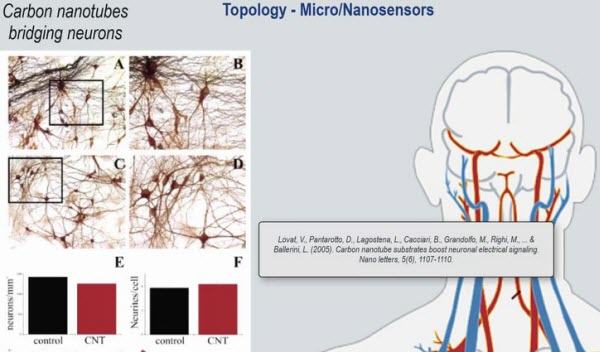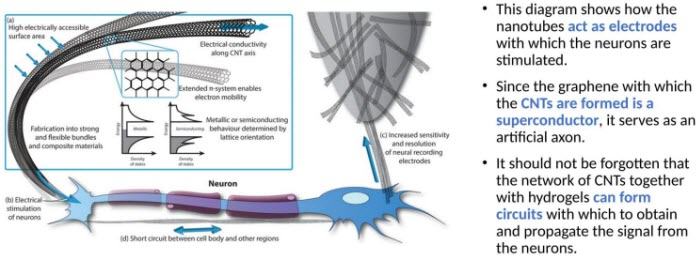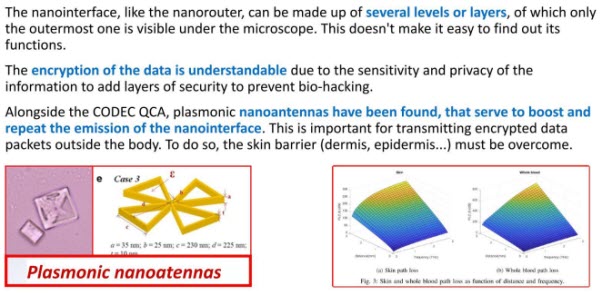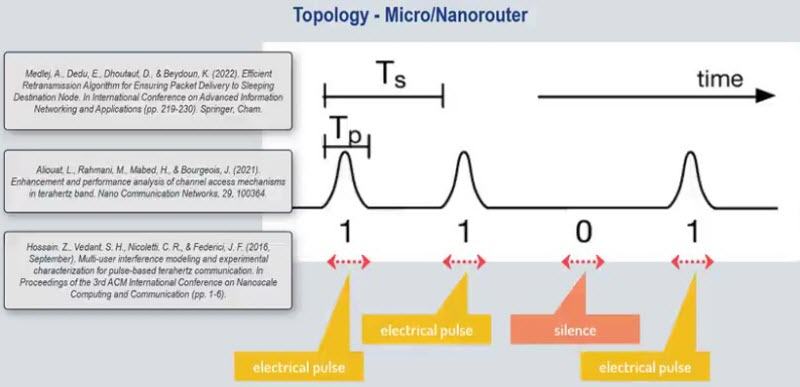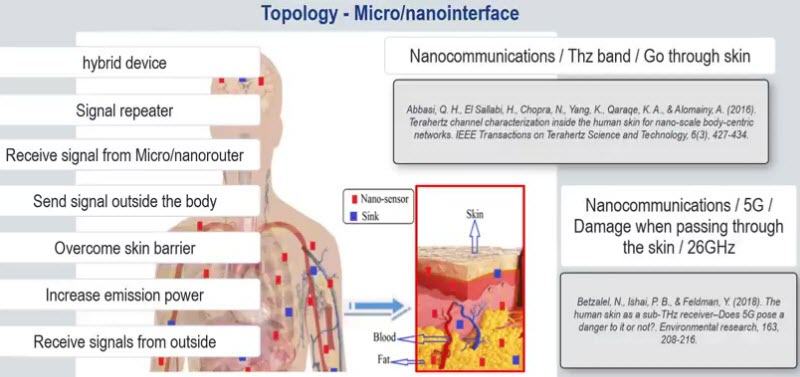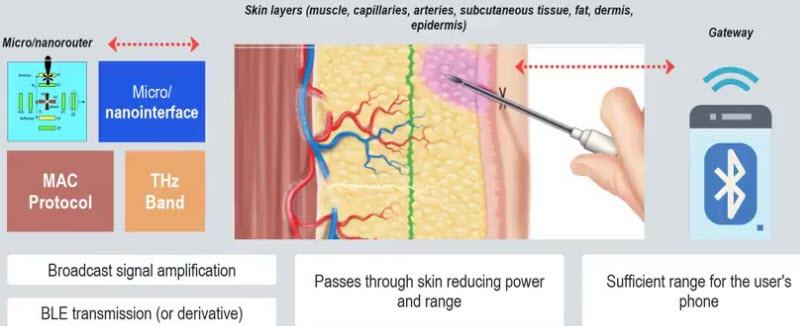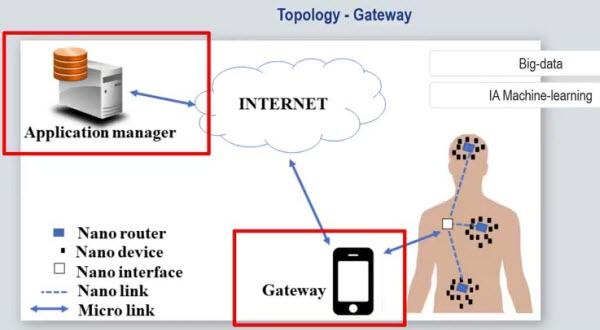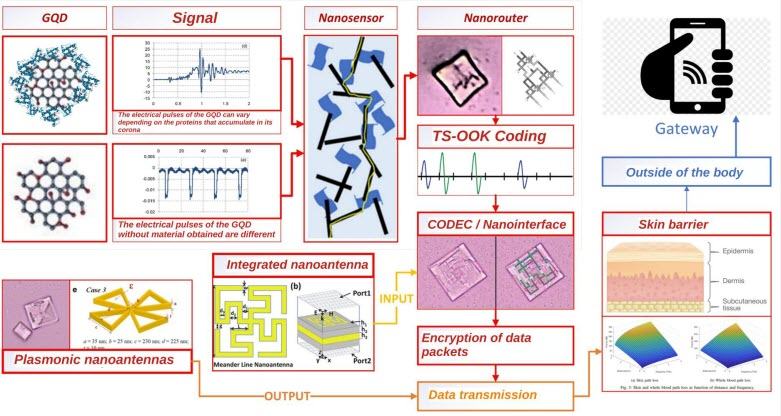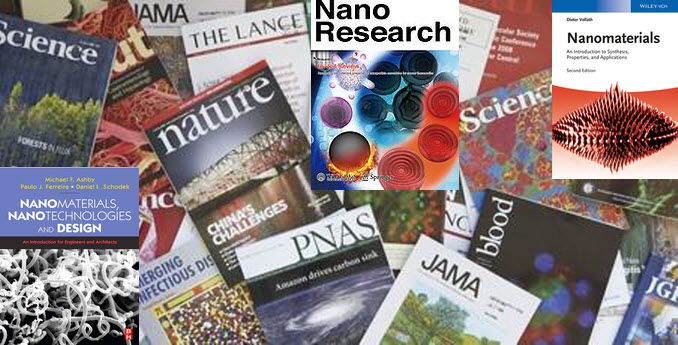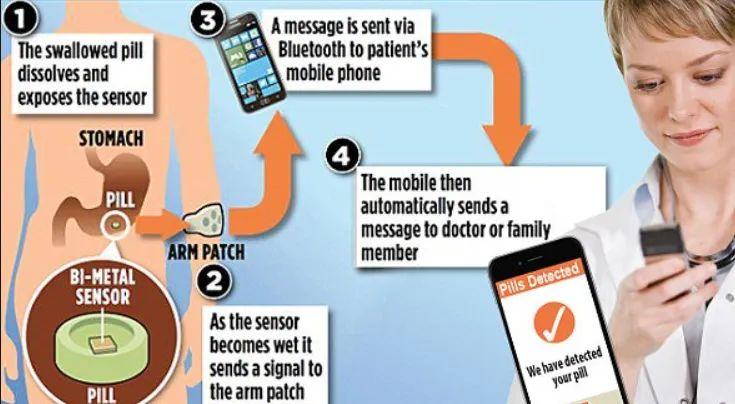Intra Body Nano Network – Part 3/5 (Meat & Potatoes – the Main Evidence)
Part 3 of 5 of the Intra Body Nano Network by Mik Andersen. Part three is really the meat & potatoes of the presentation. It goes through what is in the scientific literature regarding micro and nano sensors, carbon nanotubes, graphene and graphene oxide nanosheets, Micro and Nano routers. micro antennas or plasmonic nanoantennae microsensors, micro node signals (TS-OOK) and how our phone, tablet or can be used as the gateway.
Intra-body nano-network – Part 3 of 5 – Micro/Nanointerface, Micro/Nano routers/sensors, TS-OOK signals, Gateway.
- Micro/Nanosensors.
Sensors at both scales are described in the scientific literature as simple devices for monitoring physiological parameters – collecting electrical signals, and metric and quantitative evaluations in the human body – but also as an interface for interaction with target organs.
For example, Micro/Nanosensors can be made up of a lattice of graphene nanosheets and carbon nanotubes or carbon fibres.
These lattices adhere to:
- the walls of the endothelium,
- the cardiac and arterial system,
- and even in brain tissue due to their ability to overcome the blood-brain barrier. (01) (02)
Once established, they generate electrical conduction paths, equivalent to the wires of a circuit, which, together with the superconducting capacity of the material, becomes a field effect transistor. (03)
This makes it possible to detect the electrical pulses of the organ with which it is in contact, for example, the heart, the brain, or the alveolar tissue in the lungs, but also to interact by emitting electrical discharges, since they can also act as supercapacitors (due to the piezoelectric properties they possess).
In this sense, they would act as an interface since, given a certain signal at the appropriate frequency, they could trigger these discharge operations.
This, applied to sensitive organs such as the heart and even the respiratory system, could cause choking sensations, feinting, arrhythmias or heart attacks. (04)
In the case of brain tissue, the scientific literature is very profuse and includes a multitude of experiments and tests with carbon nanotubes and graphene and graphene oxide nanosheets to act as electrodes, capable of acting as bridges between neurons and stimulating their electrical activity. (08)
Which makes it possible, de facto, to create artificial axons and influence the segregation of neurotransmitters.
- Graphene and CNT nanosheets as neural interface (09)
- CNT as cardiac interface, regulator of its performance (10)
- CNT as electrodes for neurostimulation (11)
- Behaviour of graphene and CNT in neuronal tissue (12)
Presumably, this would make it possible to:
- interfere with the proper functioning of a person’s psyche,
- monitor the electrical conductivity of brain regions,
- alter behaviour, thinking, conduct, and so on.
- Micro/Nano router.
These are devices whose function is to collect and process the data obtained through the nano nodes and nano sensors, sending and propagating the information to the micro or nano interface so that the data is transmitted from the inside to the outside of the body. (13)
It can also act in the opposite direction, that is, from outside to inside the body, for which it will receive the signal from the micro/nano interface, decoding and routing it to retransmit it to the rest of the elements of the intracorporal network.
In many references consulted, these routers consist of micro antennas or plasmonic nanoantennae, transmission circuits, encoding and decoding of signals according to a MAC protocol which determines the rules of construction of messages and antenna emissions. (14) (15)
In addition, these micro routers are responsible for translating the lower-level signals produced by the microsensors and micro node signals known as TS-OOK.
- TS-OOK signals and MAC protocols for nano networks (16)
- TS-OOK/THz band in-body nanocommunications (17)
- In-vivo nanocommunications / TS-OOK scheme (18)
- Propagation in human tissues / THz / TS-OOK (19)
TS-OOK signals are the most recognised in all scientific papers on intracorporal networks because they have a low energy emission cost. (20) (21) (22) (23)
Also, because of their simplicity due to the fact that they are binary signals, which collect electrical pulses with value “one” and silences with value “zero.”
In this way, the potential variations and pulses sensed by the micro/nano sensors and micro nodes throughout the body can be transmitted in TS-OOK, so that they can be received by the micro/nano router.
- MAC protocol / Nano-networks / Nanorouter / In-body (24)
- MAC protocol / Nano-networks / Energy efficiency (25)
- Cooperative nanocommunication / Nanorouter / In-body (26)
- MAC Protocol (27)
According to the scientific literature, the micro/nano router could be the key to the phenomenon of MAC broadcasts, since the data sent from inside to outside the human body is transmitted according to a medium access protocol which determines headers, data packet structures, coding, frequency hopping map, encryption, and so on. (28) (29)
Being able to detect MAC addresses means that the designers of the intracorporal network most likely designed it to use Bluetooth low energy protocols, also known as BLE – Bluetooth Low Energy. (30)
However, being able to see and detect these MACs on the cell phone does not mean that they use exactly the same protocols.
In fact, it is not possible to link or connect to the anonymous MAC devices.
- Data transmission / In-Vivo / Intrabody communication / Bluetooth low energy BLE (31)
- MAC / Nanocommuications / WBAN (32)
- Micro/Nanointerface.
It is defined in the scientific literature as a hybrid device responsible for capturing the signals emitted from the outside and transmitting them inward or performing the reverse process outward to emit data.
Its function is to pass through the skin barrier, which greatly reduces the effectiveness of the emissions. Therefore, it could be considered a repeater and signal amplifier.
- Nanocommunications / Thz band / Go through skin (33)
- Nanocommunications / 5G / Damage when passing through the skin / 26GHz (34)
This device maintains communication with the micro/nano router, reproducing the transmission of data packets, according to the MAC protocol. The range of the micro/nano interface emissions is limited according to the literature consulted. Specifically, a few metres due to the mitigation of the signal caused by the layers of the skin.
However, a long transmission distance is not necessary either, considering that the recipient of the signals is the user’s cell phone, also known as the “gateway,” which will be responsible for transmitting the data packets to one or more recipients via the Internet.
- Gateway.
As indicated above, the objective of the emissions from the micro/nano router and the micro/nano interface is to reach the gateway, recognised in various publications as the cell phone, tablet, or wearable device with an internet connection.
- Part One: Summary & MAC phenomenon (3min)
- Part 1 summarizes the presentation and gives instructions on how to test the Bluetooth/MAC address phenomenon for yourself.
- Part Two: Intra-Body Nano-Network: Graphene quantum dots / Nanonodes (3min)
- Part 2 of 5 of the Intra Body Nano Network by Mik Andersen. Part two introduces micro or nanoscale devices using graphene quantum dots, which, if present inside the human body can make up an Intracorporal Wireless Network of Nano Communications.
- Part Three: Micro/Nanointerface, Micro/Nano routers/sensors, TS-OOK signals, Gateway. (5min)
- Part 3 is really the meat & potatoes of the presentation. It goes through what is in the scientific literature regarding micro and nano sensors, carbon nanotubes, graphene and graphene oxide nanosheets, Micro and Nano routers. micro antennas or plasmonic nanoantennae microsensors, micro node signals (TS-OOK) and how our phone, tablet or can be used as the gateway.
- Part Four: Possible Uses: Mind-control & Population control: Neurosurveillance, Neuromodulation, Neurostimulation, Human connectivity (4min)
- Part 4 is about hypothesizing if this technology is in us, what it could be used for.
- Part Five: Possible Uses: Social Credit System, Eugenics, Targeted traceless weapon, & Refs (3min)
- Part 5 continues hypothesizing if this technology is in us, what it could be used for on a more devastating level regarding population control, selective genocide, and eugenics. This post also contains the references he listed in his presentation. (4min)

Site Notifications/Chat:
- Telegram Post Updates @JourneyToABetterLife (channel)
- Telegram Chatroom @JourneyBetterLifeCHAT (say hi / share info)
- Gettr Post Updates @chesaus (like fakebook)
Videos:
References

